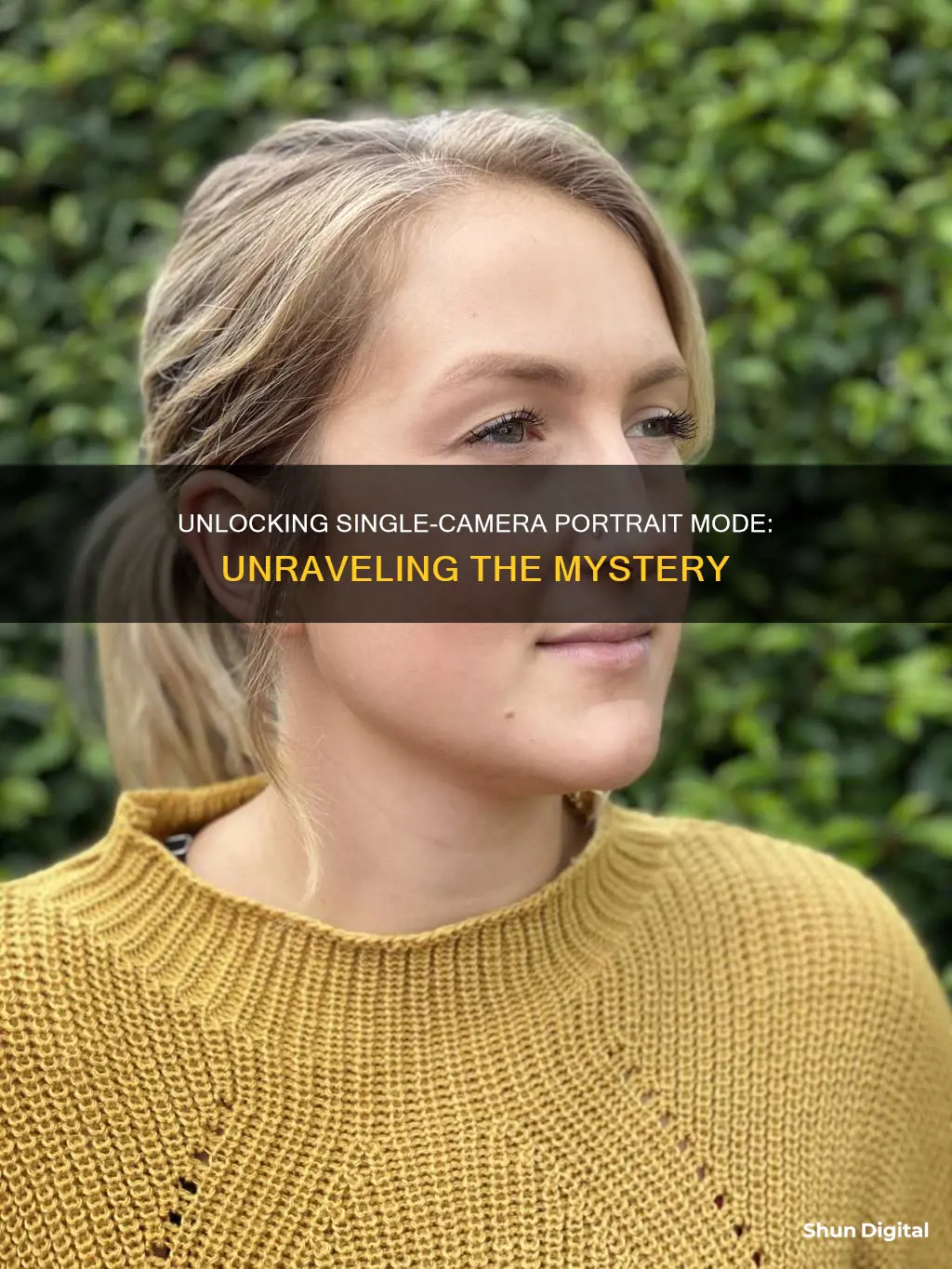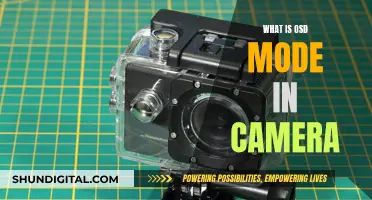
Single-camera portrait mode is a feature on some smartphones that helps users take better pictures of people by capturing a sharp image of the face and blurring the background. This mode was made possible by training deep-learning algorithms on approximately 100,000 photos, allowing single-camera devices to take portrait photos. This feature is designed to improve close-up photos of a single person, using computational photography to artificially blur the background and mimic the effect of a DSLR camera.
| Characteristics | Values |
|---|---|
| Purpose | To take better pictures of people by capturing a sharp face and a nicely blurred background |
| Image Type | Specifically made to improve close-up photos of one person |
| Image Name | The name "portrait" comes from the type of image, which is a picture that mainly focuses on a person's face or upper body |
| Image Quality | The quality of images produced with single-camera portrait mode is almost indistinguishable from larger-sensor cameras |
| Hardware | Single-camera devices |
| Software | Computational photography, edge detection, depth mapping, machine learning, pixel splitting |
| Implementation | Semantic segmentation, i.e. differentiating between the background and foreground in an image |
| Result | A blurred background that draws the eye to the subject and eliminates distractions |
What You'll Learn

How does single-camera portrait mode work?
Portrait mode is a feature on many smartphones that helps users take better pictures of people by capturing a sharp image of the face and blurring the background. It is specifically designed to improve close-up photos of one person, although it can also be used for objects.
Portrait mode is a form of computational photography that artificially applies blur to the background. This is done to mimic the background blur of a DSLR camera, which has a larger sensor and adjustable aperture, allowing for a more prominent blur effect.
Smartphone cameras, on the other hand, have tiny sensors and fixed apertures, making it difficult to achieve this level of blur unless you are very close to the subject. That's where portrait mode comes in. With the help of a secondary camera sensor or software, portrait mode differentiates between the background and the subject and applies a blur effect to the background, replicating the look of a professional camera.
There are different implementations of portrait mode. Some smartphones, like the iPhone 7 Plus, use a dual-camera system with two lenses to create a "depth map" of the image and determine what to blur. Others, like the Google Pixel 2, use a single camera with computational algorithms to detect and differentiate between the background and the subject. This allows the Pixel 2 to take portrait mode shots from the front-facing camera.
Portrait mode on smartphones has evolved to the point where, to the untrained eye, images produced with dual cameras and defocus algorithms are almost indistinguishable from those taken with larger sensor cameras.
Charging Camera Batteries: How Long is Too Long?
You may want to see also

How does it compare to dual-camera portrait mode?
Single-camera portrait mode uses computational algorithms to detect and differentiate between the background and the subject. This allows the camera to apply a blur effect to the background, replicating the look of a professional camera with a shallow depth of field. This effect is achieved through edge detection and/or depth mapping, which identifies the foreground and background of an image and blurs the background to make the foreground pop.
Dual-camera portrait mode, on the other hand, utilises two lenses to create a depth map of the image. The iPhone X and Note 8, for example, use data from wide-angle and telephoto lenses to create this depth map and then artificially blur objects depending on their distance from the subject. This results in a more natural-looking image, as the blur effect is based on the physical distance between the lenses and the subject.
The Pixel 2, however, achieves a similar effect using a single camera. It utilises pixel-splitting technology and machine learning to identify the subject and create a mask, allowing it to take portrait mode shots from the front-facing camera. This approach results in a more accurate differentiation between the subject and the background, leading to a more natural-looking image overall.
In terms of image quality, dual-camera systems generally produce more natural-looking images, especially when it comes to human subjects. Single-camera systems, like the one used in the Pixel 2, may struggle to keep the entire subject in focus and may apply aggressive sharpening and blurring, resulting in a less natural look. However, single-camera systems have the advantage of being able to take portrait mode shots from the front-facing camera, which is not always possible with dual-camera systems.
It's worth noting that the capabilities of smartphone camera software and hardware are advancing rapidly, and the differences between single-camera and dual-camera portrait modes may become less significant over time. As Brownlee points out, "the best camera is still just the one you have with you", and both single-camera and dual-camera portrait modes offer impressive results that can rival those of larger sensor cameras.
Unleash Camera Raw: Bridge's Hidden Gem
You may want to see also

Which phones have single-camera portrait mode?
Single-camera portrait mode is a setting in smartphone cameras that creates a shallow depth of field, blurring the background of a photo and bringing the subject into sharp focus. This is known as the bokeh effect, and it is usually achieved using a DSLR or mirrorless camera with specialised lenses, larger sensors, and high focal lengths.
Several smartphone manufacturers have introduced single-camera portrait mode, including Apple, Xiaomi, and OnePlus.
- IPhone 7 Plus and newer models (iPhone 8 Plus, iPhone 11 Pro Max, iPhone 11 Pro, etc.)
- Xiaomi Redmi Note 4, Xiaomi Redmi Note 4X, Xiaomi Mi 6, and Xiaomi Redmi Note 5
- OnePlus 12
Other phones that have portrait mode capabilities, but it is unclear if they use a single or multiple cameras, include:
- Motorola Edge 50 Fusion
- OnePlus Nord CE 4 5G
- Motorola Edge 50 Pro 5G
- Realme C65 5G 8GB RAM
- Google Pixel 9 Pro XL 512GB
- Samsung Galaxy S24 Ultra
Disney's Camera Battery Chargers: A Photographer's Lifeline
You may want to see also

How does it compare to a 'proper' camera?
Portrait mode on a single-camera smartphone simulates a shallow depth of field by using edge detection and/or depth mapping to differentiate between the foreground and background. It then blurs the background, simulating that shallow depth of field and making the foreground pop. This is a feature commonly called 'Portrait Mode'.
The iPhone X and Note 8 use depth mapping to figure out what is in the foreground of the image. They use data from the wide-angle and telephoto lenses to create a depth map, and then artificially blur objects depending on how far they are from the in-focus subject. The Pixel 2 takes a different approach, utilising pixel splitting to create a depth map and machine learning to identify the subject and create a mask.
The resulting images differ between the phones. The iPhone X appears to focus on the face at the expense of everything else, often resulting in blurred hair, ears, or other objects in the same plane of focus as the face. The Pixel 2 seems to do a better job of keeping the entire subject in focus, but applies very strong sharpening to the foreground and aggressively blurs the background, resulting in a less natural-looking image. The Note 8 is somewhere in the middle.
Portrait mode is clearly inferior when it comes to non-human subjects. The strength of the mode on any device running iOS or Android is the ability to recognise faces. As humans, we are hard-wired to recognise faces, so the algorithms in the camera app tend to pay special attention to the face, foregoing all other details.
Smartphone camera software and hardware are improving at a faster rate than traditional cameras. Features like increasing the amount of background blur after the shot is taken or the artificial lighting effects like those offered by the iPhone X are things that traditional cameras do not have.
While smartphone cameras are improving, there are still some limitations. The physical constraints of a small sensor and wide aperture on a smartphone make it difficult to achieve the same level of bokeh as a dedicated camera unless you are very close to the subject. However, this is changing as some smartphones now have larger sensors and advanced computational photography.
The best camera is the one you have with you, and smartphone cameras are getting so good that it can be difficult to differentiate their images from those taken with a dedicated camera.
Mastering the Art of Hiding Pins in Camera Raw Adjustment Brush
You may want to see also

How do you enable single-camera portrait mode?
Single-camera portrait mode is a feature on some smartphones that allows you to take photos with a blurred background, similar to those taken with a DSLR camera. This mode is particularly useful for taking portraits, as it keeps the subject in focus while blurring the background, creating a shallow depth of field or "bokeh" effect.
To enable single-camera portrait mode on your phone, follow these steps:
For iPhones:
- Open the camera app.
- Swipe through the various effects along the bottom above the shutter button and select "Portrait".
- Aim your camera at the subject, ensuring they are within two to eight feet from your phone.
- When portrait mode is active, a yellow box will appear on the screen. For newer iPhone models, you can adjust the lighting as needed.
- Take your picture by pressing the shutter button.
For Android devices:
- Open the camera app.
- Select the menu button or swipe to choose the portrait option.
- Point your phone at the subject and take a picture by pressing the shutter button.
It is worth noting that single-camera portrait mode may be called something different on your device, such as "Live Focus", "Bokeh Mode", or "Lens Blur".
Additionally, if your device does not have a built-in portrait mode, you can use third-party apps to achieve a similar effect. For example, the Google Camera app uses computational photography algorithms to create portrait mode shots. Alternatively, you can use a photo editor like PicsArt to blur the background of an image after it has been taken.
Enabling Single-Camera Portrait Mode on Older iPhones:
If you have an older iPhone model that does not support portrait mode by default, there are tweaks available that can add this functionality. For example, the "PortraitXI" tweak allows users of iPhone 6s and above to take portrait mode photos with a single camera. This tweak can be installed via a jailbreak and is available on the Packix repo.
Once installed, a "PortraitXI" button will appear next to the switch camera button in the camera app. Simply tap on it to enable single-camera portrait mode and take your photo as usual.
Smart Guide: Universal Charger for Fuji NP-W126
You may want to see also
Frequently asked questions
Single-camera portrait mode is a feature on some smartphones that helps you take better pictures of people by capturing a sharp image of the face and blurring the background.
Single-camera portrait mode uses computational photography, which relies on a mix of software and hardware, to artificially blur the background of an image.
The purpose of single-camera portrait mode is to simulate the shallow depth of field effect typically achieved with larger cameras, creating a more professional-looking image.
Dual-camera portrait mode uses two lenses to create a depth map, which helps the camera differentiate between the foreground and background. Single-camera portrait mode relies on computational algorithms and software to achieve the same effect.
Several Xiaomi phones, including the Redmi Note 4 and Redmi Note 4X, have single-camera portrait mode with the MIUI 10 update.







